Financial Audit of TCW Ltd: Risk Analysis & Control Evaluation
VerifiedAdded on 2023/06/04
|16
|2929
|275
Report
AI Summary
This report provides a detailed analysis of the financial audit of Trunkey Creek Wines (TCW) Ltd, a valuable client of MYH. It identifies key audit risks associated with specific accounts such as accounts receivable, property assets, investments, and marketing expenses. The report also discusses various business operation risks that could hinder the company's objectives. Furthermore, it evaluates the effectiveness of TCW Ltd's internal controls in mitigating these risks, while also highlighting weaknesses in the company's internal control system for purchases and payments. The auditor's procedures for alleviating identified risks are outlined, along with an assessment of strategic, compliance, operational, financial, technological, human, physical, competitive, and legal risks faced by the company. The report also includes a discussion of potentially effective internal controls and identified weaknesses in the accounts payable and purchasing processes.
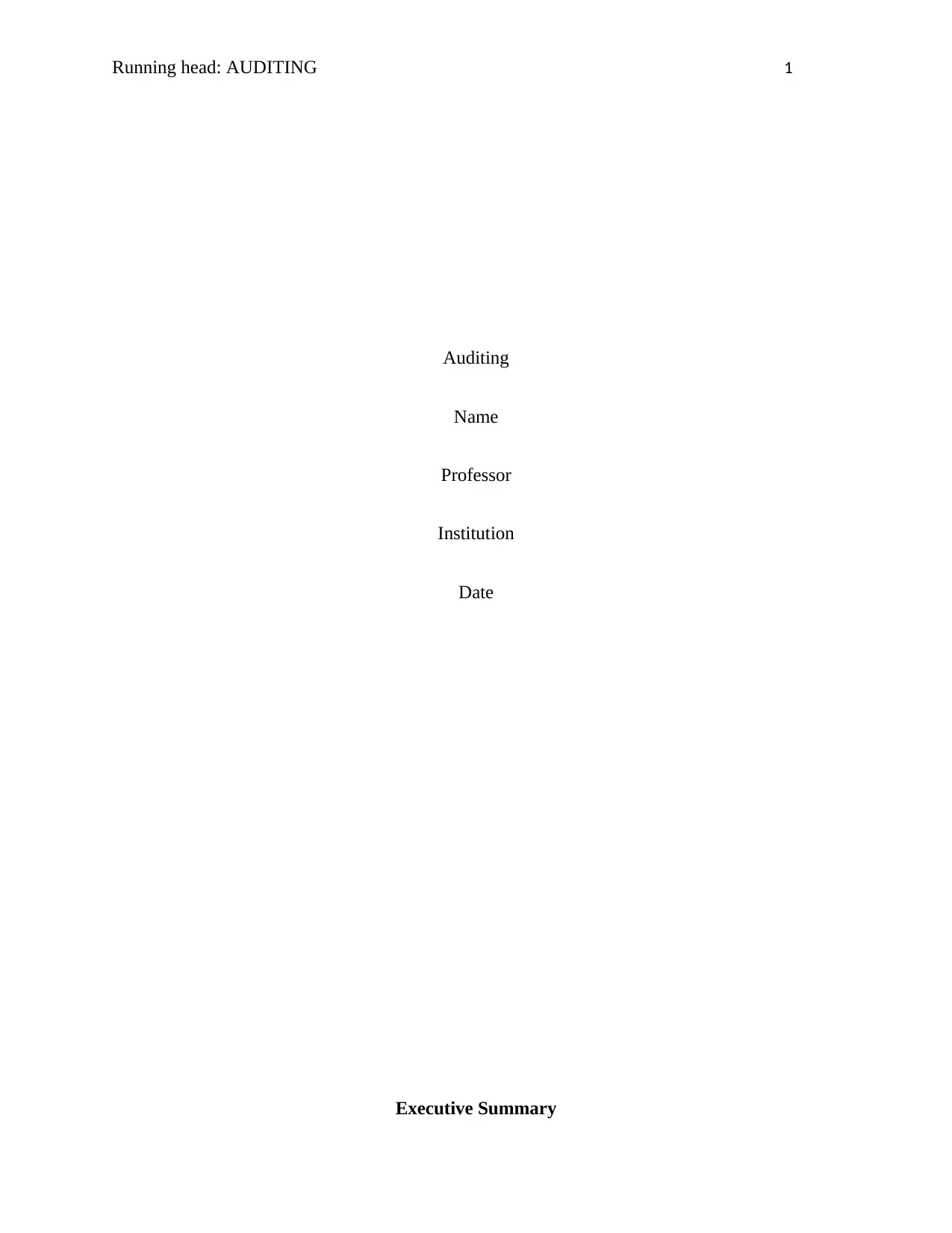
Running head: AUDITING 1
Auditing
Name
Professor
Institution
Date
Executive Summary
Auditing
Name
Professor
Institution
Date
Executive Summary
Paraphrase This Document
Need a fresh take? Get an instant paraphrase of this document with our AI Paraphraser
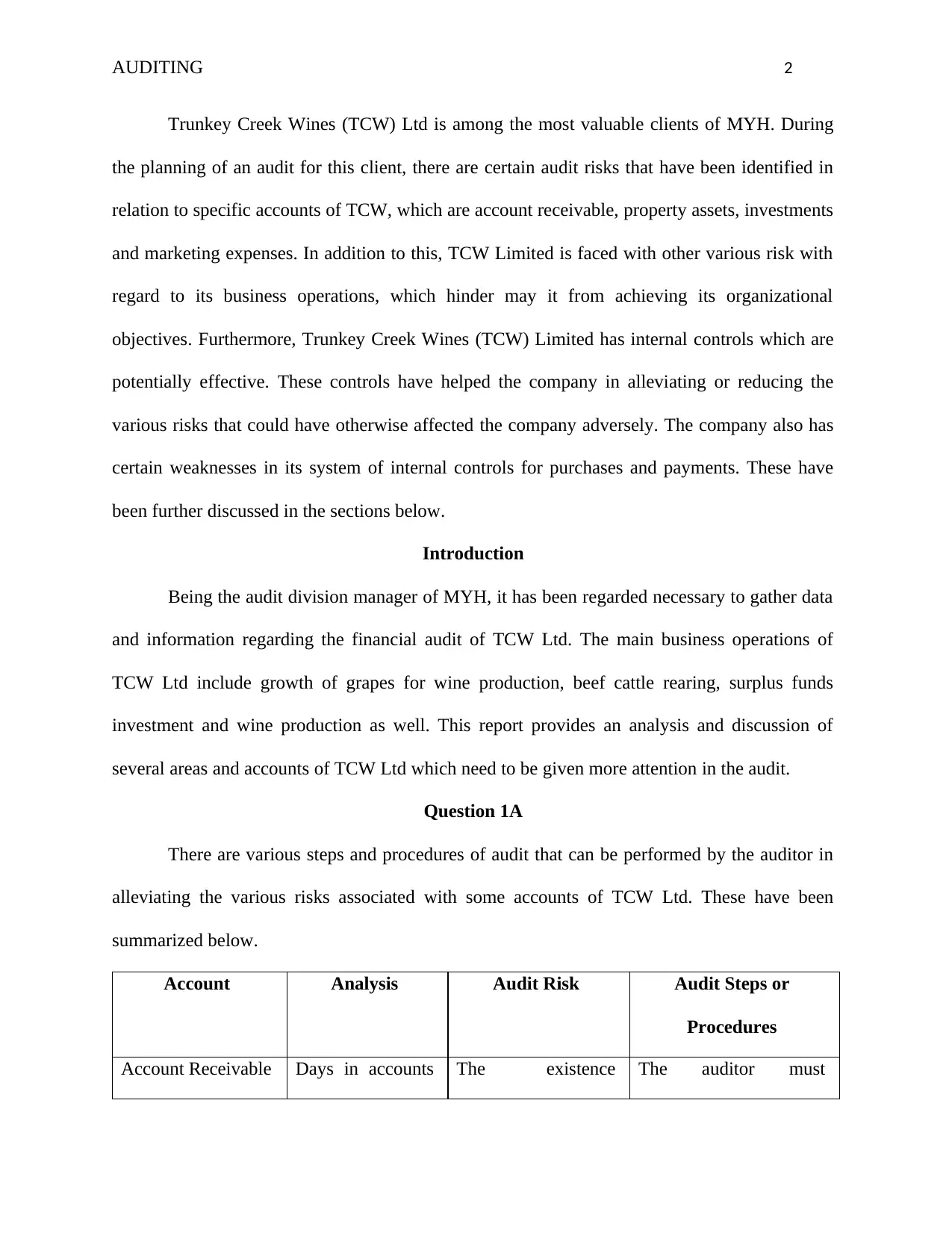
AUDITING 2
Trunkey Creek Wines (TCW) Ltd is among the most valuable clients of MYH. During
the planning of an audit for this client, there are certain audit risks that have been identified in
relation to specific accounts of TCW, which are account receivable, property assets, investments
and marketing expenses. In addition to this, TCW Limited is faced with other various risk with
regard to its business operations, which hinder may it from achieving its organizational
objectives. Furthermore, Trunkey Creek Wines (TCW) Limited has internal controls which are
potentially effective. These controls have helped the company in alleviating or reducing the
various risks that could have otherwise affected the company adversely. The company also has
certain weaknesses in its system of internal controls for purchases and payments. These have
been further discussed in the sections below.
Introduction
Being the audit division manager of MYH, it has been regarded necessary to gather data
and information regarding the financial audit of TCW Ltd. The main business operations of
TCW Ltd include growth of grapes for wine production, beef cattle rearing, surplus funds
investment and wine production as well. This report provides an analysis and discussion of
several areas and accounts of TCW Ltd which need to be given more attention in the audit.
Question 1A
There are various steps and procedures of audit that can be performed by the auditor in
alleviating the various risks associated with some accounts of TCW Ltd. These have been
summarized below.
Account Analysis Audit Risk Audit Steps or
Procedures
Account Receivable Days in accounts The existence The auditor must
Trunkey Creek Wines (TCW) Ltd is among the most valuable clients of MYH. During
the planning of an audit for this client, there are certain audit risks that have been identified in
relation to specific accounts of TCW, which are account receivable, property assets, investments
and marketing expenses. In addition to this, TCW Limited is faced with other various risk with
regard to its business operations, which hinder may it from achieving its organizational
objectives. Furthermore, Trunkey Creek Wines (TCW) Limited has internal controls which are
potentially effective. These controls have helped the company in alleviating or reducing the
various risks that could have otherwise affected the company adversely. The company also has
certain weaknesses in its system of internal controls for purchases and payments. These have
been further discussed in the sections below.
Introduction
Being the audit division manager of MYH, it has been regarded necessary to gather data
and information regarding the financial audit of TCW Ltd. The main business operations of
TCW Ltd include growth of grapes for wine production, beef cattle rearing, surplus funds
investment and wine production as well. This report provides an analysis and discussion of
several areas and accounts of TCW Ltd which need to be given more attention in the audit.
Question 1A
There are various steps and procedures of audit that can be performed by the auditor in
alleviating the various risks associated with some accounts of TCW Ltd. These have been
summarized below.
Account Analysis Audit Risk Audit Steps or
Procedures
Account Receivable Days in accounts The existence The auditor must
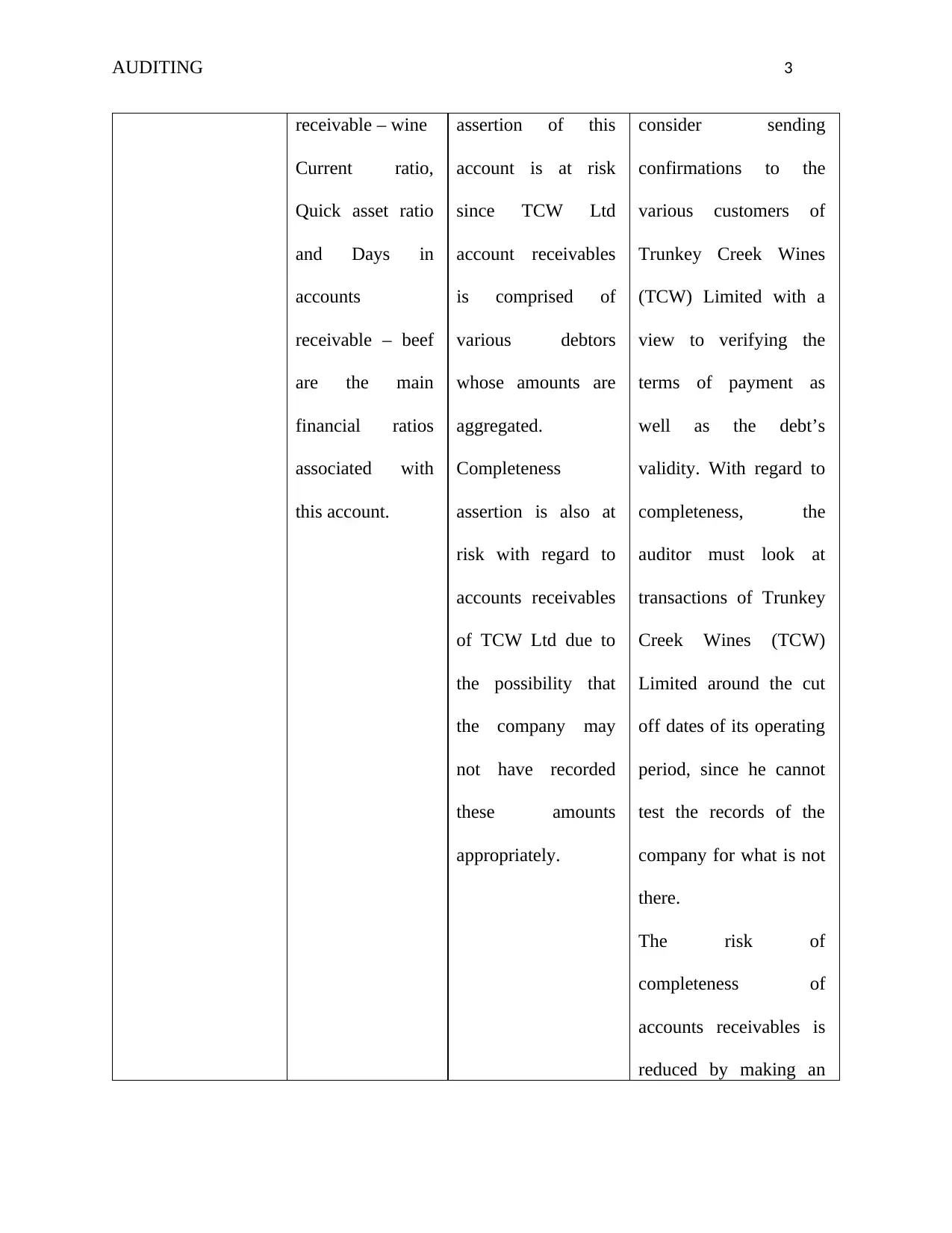
AUDITING 3
receivable – wine
Current ratio,
Quick asset ratio
and Days in
accounts
receivable – beef
are the main
financial ratios
associated with
this account.
assertion of this
account is at risk
since TCW Ltd
account receivables
is comprised of
various debtors
whose amounts are
aggregated.
Completeness
assertion is also at
risk with regard to
accounts receivables
of TCW Ltd due to
the possibility that
the company may
not have recorded
these amounts
appropriately.
consider sending
confirmations to the
various customers of
Trunkey Creek Wines
(TCW) Limited with a
view to verifying the
terms of payment as
well as the debt’s
validity. With regard to
completeness, the
auditor must look at
transactions of Trunkey
Creek Wines (TCW)
Limited around the cut
off dates of its operating
period, since he cannot
test the records of the
company for what is not
there.
The risk of
completeness of
accounts receivables is
reduced by making an
receivable – wine
Current ratio,
Quick asset ratio
and Days in
accounts
receivable – beef
are the main
financial ratios
associated with
this account.
assertion of this
account is at risk
since TCW Ltd
account receivables
is comprised of
various debtors
whose amounts are
aggregated.
Completeness
assertion is also at
risk with regard to
accounts receivables
of TCW Ltd due to
the possibility that
the company may
not have recorded
these amounts
appropriately.
consider sending
confirmations to the
various customers of
Trunkey Creek Wines
(TCW) Limited with a
view to verifying the
terms of payment as
well as the debt’s
validity. With regard to
completeness, the
auditor must look at
transactions of Trunkey
Creek Wines (TCW)
Limited around the cut
off dates of its operating
period, since he cannot
test the records of the
company for what is not
there.
The risk of
completeness of
accounts receivables is
reduced by making an
⊘ This is a preview!⊘
Do you want full access?
Subscribe today to unlock all pages.

Trusted by 1+ million students worldwide
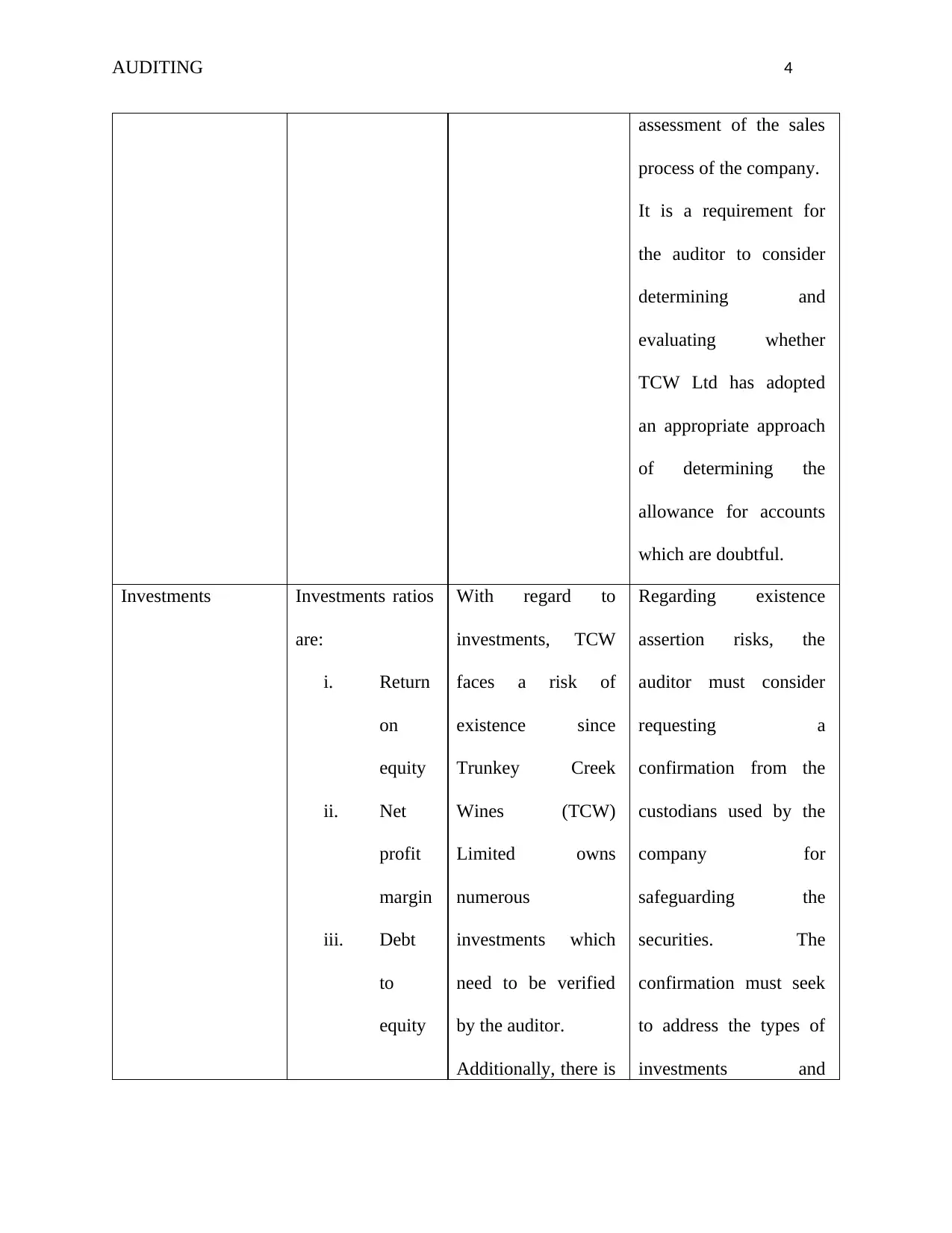
AUDITING 4
assessment of the sales
process of the company.
It is a requirement for
the auditor to consider
determining and
evaluating whether
TCW Ltd has adopted
an appropriate approach
of determining the
allowance for accounts
which are doubtful.
Investments Investments ratios
are:
i. Return
on
equity
ii. Net
profit
margin
iii. Debt
to
equity
With regard to
investments, TCW
faces a risk of
existence since
Trunkey Creek
Wines (TCW)
Limited owns
numerous
investments which
need to be verified
by the auditor.
Additionally, there is
Regarding existence
assertion risks, the
auditor must consider
requesting a
confirmation from the
custodians used by the
company for
safeguarding the
securities. The
confirmation must seek
to address the types of
investments and
assessment of the sales
process of the company.
It is a requirement for
the auditor to consider
determining and
evaluating whether
TCW Ltd has adopted
an appropriate approach
of determining the
allowance for accounts
which are doubtful.
Investments Investments ratios
are:
i. Return
on
equity
ii. Net
profit
margin
iii. Debt
to
equity
With regard to
investments, TCW
faces a risk of
existence since
Trunkey Creek
Wines (TCW)
Limited owns
numerous
investments which
need to be verified
by the auditor.
Additionally, there is
Regarding existence
assertion risks, the
auditor must consider
requesting a
confirmation from the
custodians used by the
company for
safeguarding the
securities. The
confirmation must seek
to address the types of
investments and
Paraphrase This Document
Need a fresh take? Get an instant paraphrase of this document with our AI Paraphraser
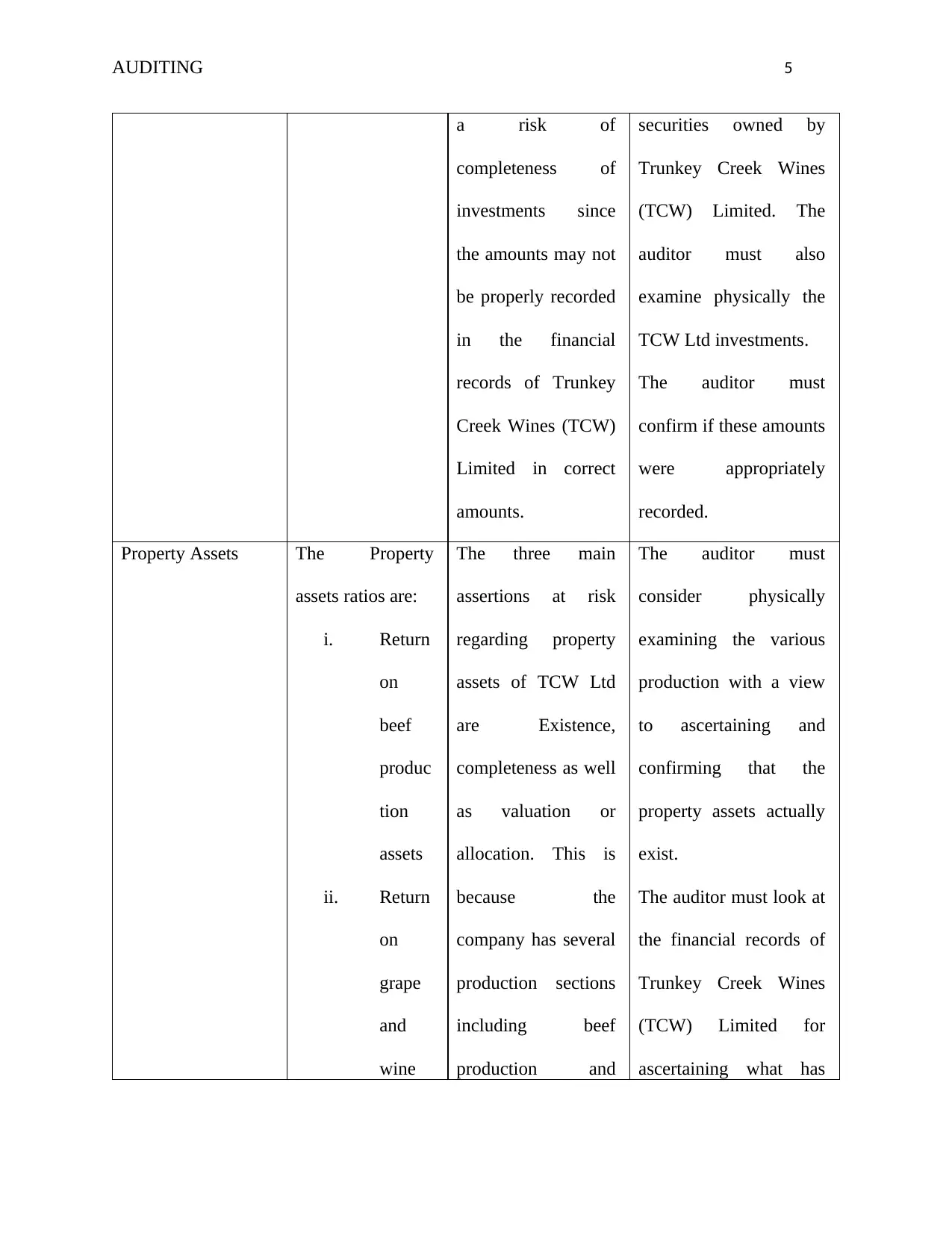
AUDITING 5
a risk of
completeness of
investments since
the amounts may not
be properly recorded
in the financial
records of Trunkey
Creek Wines (TCW)
Limited in correct
amounts.
securities owned by
Trunkey Creek Wines
(TCW) Limited. The
auditor must also
examine physically the
TCW Ltd investments.
The auditor must
confirm if these amounts
were appropriately
recorded.
Property Assets The Property
assets ratios are:
i. Return
on
beef
produc
tion
assets
ii. Return
on
grape
and
wine
The three main
assertions at risk
regarding property
assets of TCW Ltd
are Existence,
completeness as well
as valuation or
allocation. This is
because the
company has several
production sections
including beef
production and
The auditor must
consider physically
examining the various
production with a view
to ascertaining and
confirming that the
property assets actually
exist.
The auditor must look at
the financial records of
Trunkey Creek Wines
(TCW) Limited for
ascertaining what has
a risk of
completeness of
investments since
the amounts may not
be properly recorded
in the financial
records of Trunkey
Creek Wines (TCW)
Limited in correct
amounts.
securities owned by
Trunkey Creek Wines
(TCW) Limited. The
auditor must also
examine physically the
TCW Ltd investments.
The auditor must
confirm if these amounts
were appropriately
recorded.
Property Assets The Property
assets ratios are:
i. Return
on
beef
produc
tion
assets
ii. Return
on
grape
and
wine
The three main
assertions at risk
regarding property
assets of TCW Ltd
are Existence,
completeness as well
as valuation or
allocation. This is
because the
company has several
production sections
including beef
production and
The auditor must
consider physically
examining the various
production with a view
to ascertaining and
confirming that the
property assets actually
exist.
The auditor must look at
the financial records of
Trunkey Creek Wines
(TCW) Limited for
ascertaining what has
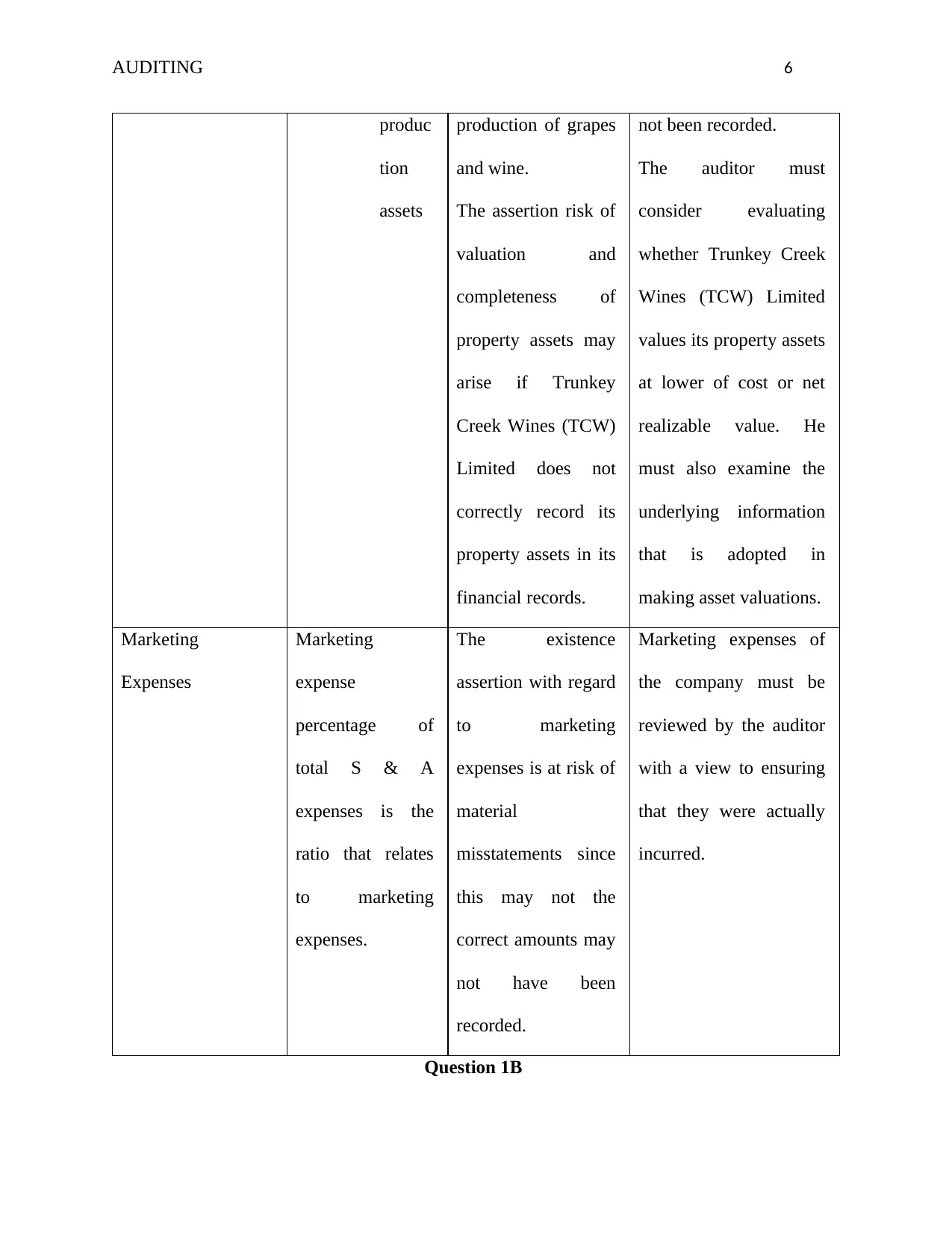
AUDITING 6
produc
tion
assets
production of grapes
and wine.
The assertion risk of
valuation and
completeness of
property assets may
arise if Trunkey
Creek Wines (TCW)
Limited does not
correctly record its
property assets in its
financial records.
not been recorded.
The auditor must
consider evaluating
whether Trunkey Creek
Wines (TCW) Limited
values its property assets
at lower of cost or net
realizable value. He
must also examine the
underlying information
that is adopted in
making asset valuations.
Marketing
Expenses
Marketing
expense
percentage of
total S & A
expenses is the
ratio that relates
to marketing
expenses.
The existence
assertion with regard
to marketing
expenses is at risk of
material
misstatements since
this may not the
correct amounts may
not have been
recorded.
Marketing expenses of
the company must be
reviewed by the auditor
with a view to ensuring
that they were actually
incurred.
Question 1B
produc
tion
assets
production of grapes
and wine.
The assertion risk of
valuation and
completeness of
property assets may
arise if Trunkey
Creek Wines (TCW)
Limited does not
correctly record its
property assets in its
financial records.
not been recorded.
The auditor must
consider evaluating
whether Trunkey Creek
Wines (TCW) Limited
values its property assets
at lower of cost or net
realizable value. He
must also examine the
underlying information
that is adopted in
making asset valuations.
Marketing
Expenses
Marketing
expense
percentage of
total S & A
expenses is the
ratio that relates
to marketing
expenses.
The existence
assertion with regard
to marketing
expenses is at risk of
material
misstatements since
this may not the
correct amounts may
not have been
recorded.
Marketing expenses of
the company must be
reviewed by the auditor
with a view to ensuring
that they were actually
incurred.
Question 1B
⊘ This is a preview!⊘
Do you want full access?
Subscribe today to unlock all pages.

Trusted by 1+ million students worldwide
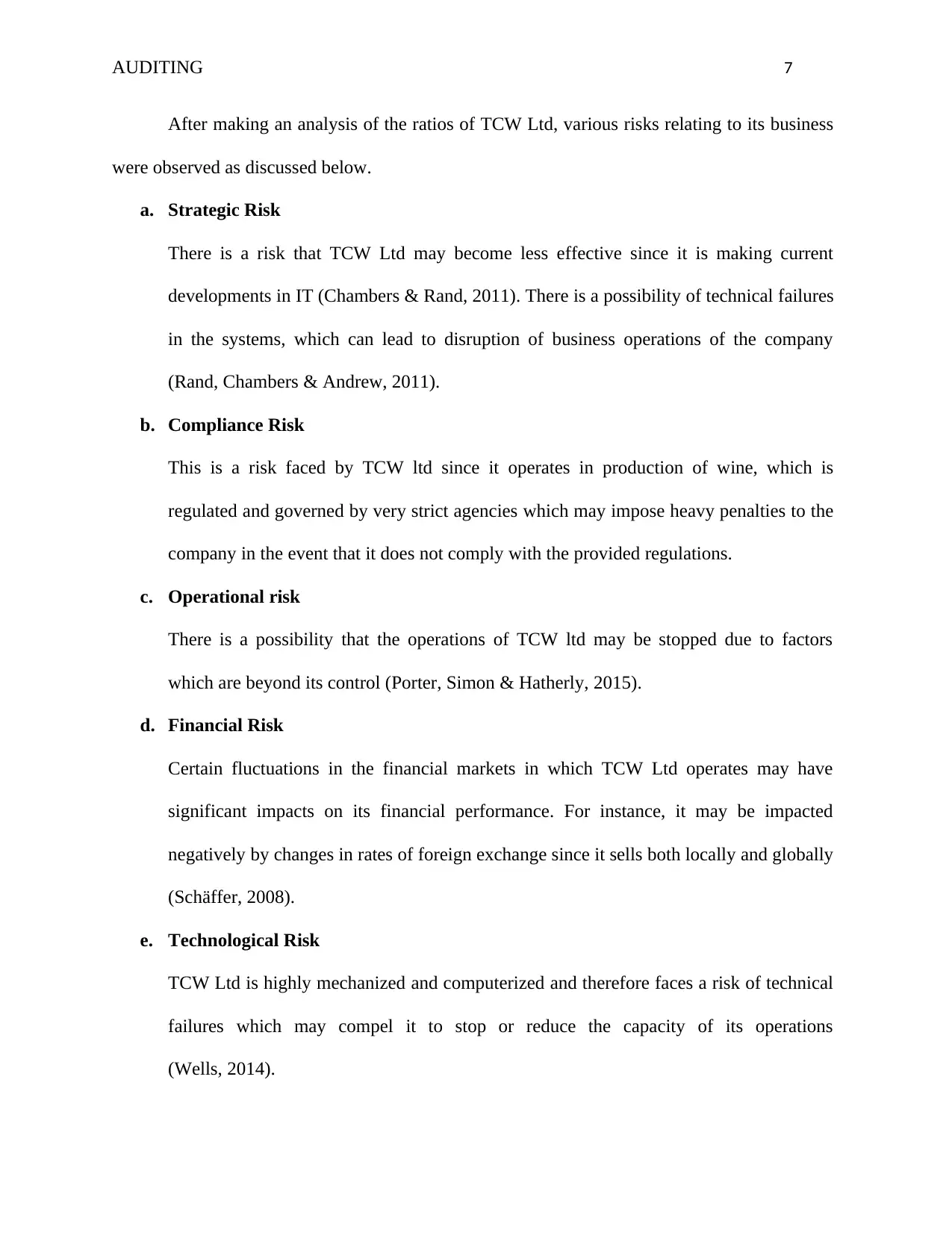
AUDITING 7
After making an analysis of the ratios of TCW Ltd, various risks relating to its business
were observed as discussed below.
a. Strategic Risk
There is a risk that TCW Ltd may become less effective since it is making current
developments in IT (Chambers & Rand, 2011). There is a possibility of technical failures
in the systems, which can lead to disruption of business operations of the company
(Rand, Chambers & Andrew, 2011).
b. Compliance Risk
This is a risk faced by TCW ltd since it operates in production of wine, which is
regulated and governed by very strict agencies which may impose heavy penalties to the
company in the event that it does not comply with the provided regulations.
c. Operational risk
There is a possibility that the operations of TCW ltd may be stopped due to factors
which are beyond its control (Porter, Simon & Hatherly, 2015).
d. Financial Risk
Certain fluctuations in the financial markets in which TCW Ltd operates may have
significant impacts on its financial performance. For instance, it may be impacted
negatively by changes in rates of foreign exchange since it sells both locally and globally
(Schäffer, 2008).
e. Technological Risk
TCW Ltd is highly mechanized and computerized and therefore faces a risk of technical
failures which may compel it to stop or reduce the capacity of its operations
(Wells, 2014).
After making an analysis of the ratios of TCW Ltd, various risks relating to its business
were observed as discussed below.
a. Strategic Risk
There is a risk that TCW Ltd may become less effective since it is making current
developments in IT (Chambers & Rand, 2011). There is a possibility of technical failures
in the systems, which can lead to disruption of business operations of the company
(Rand, Chambers & Andrew, 2011).
b. Compliance Risk
This is a risk faced by TCW ltd since it operates in production of wine, which is
regulated and governed by very strict agencies which may impose heavy penalties to the
company in the event that it does not comply with the provided regulations.
c. Operational risk
There is a possibility that the operations of TCW ltd may be stopped due to factors
which are beyond its control (Porter, Simon & Hatherly, 2015).
d. Financial Risk
Certain fluctuations in the financial markets in which TCW Ltd operates may have
significant impacts on its financial performance. For instance, it may be impacted
negatively by changes in rates of foreign exchange since it sells both locally and globally
(Schäffer, 2008).
e. Technological Risk
TCW Ltd is highly mechanized and computerized and therefore faces a risk of technical
failures which may compel it to stop or reduce the capacity of its operations
(Wells, 2014).
Paraphrase This Document
Need a fresh take? Get an instant paraphrase of this document with our AI Paraphraser
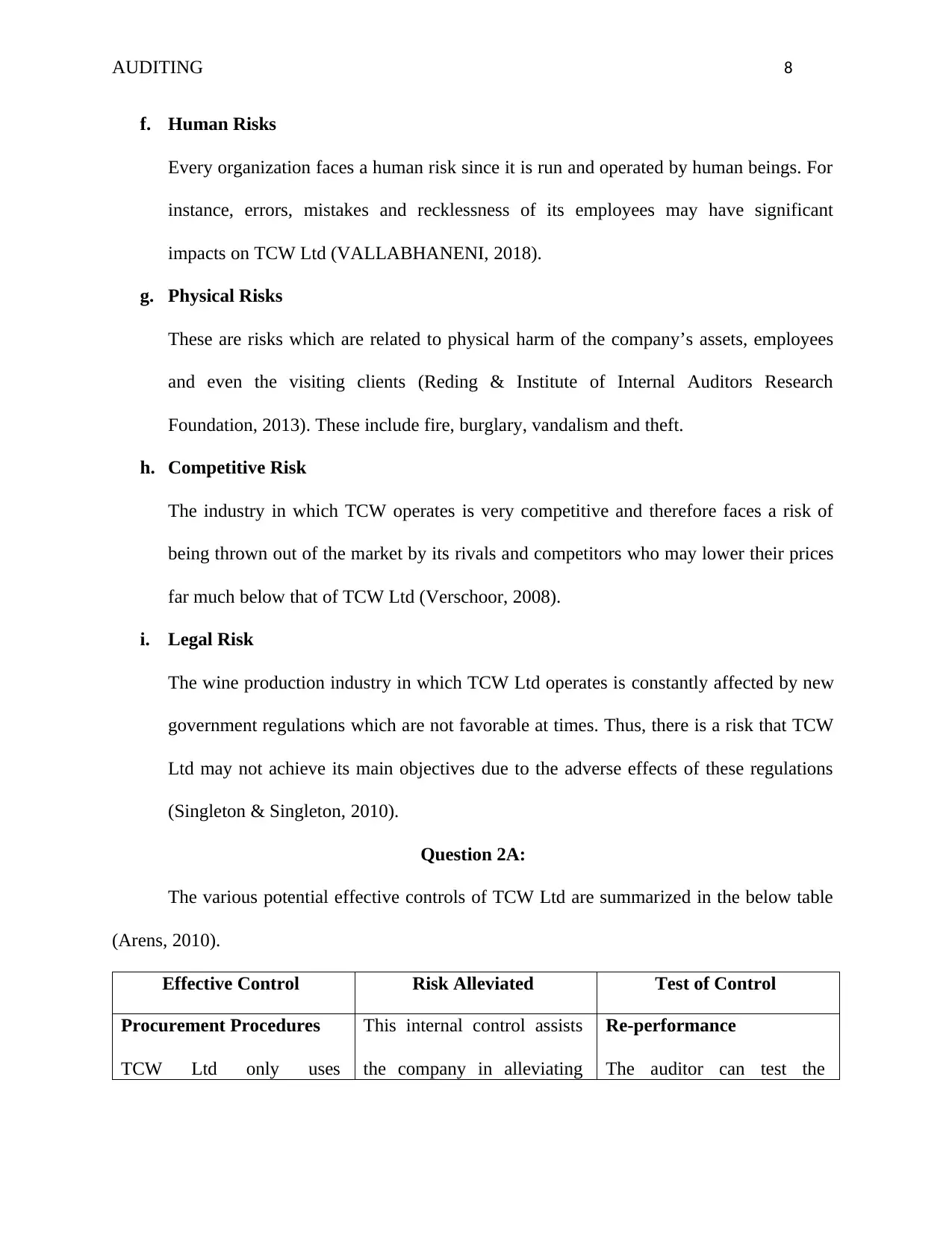
AUDITING 8
f. Human Risks
Every organization faces a human risk since it is run and operated by human beings. For
instance, errors, mistakes and recklessness of its employees may have significant
impacts on TCW Ltd (VALLABHANENI, 2018).
g. Physical Risks
These are risks which are related to physical harm of the company’s assets, employees
and even the visiting clients (Reding & Institute of Internal Auditors Research
Foundation, 2013). These include fire, burglary, vandalism and theft.
h. Competitive Risk
The industry in which TCW operates is very competitive and therefore faces a risk of
being thrown out of the market by its rivals and competitors who may lower their prices
far much below that of TCW Ltd (Verschoor, 2008).
i. Legal Risk
The wine production industry in which TCW Ltd operates is constantly affected by new
government regulations which are not favorable at times. Thus, there is a risk that TCW
Ltd may not achieve its main objectives due to the adverse effects of these regulations
(Singleton & Singleton, 2010).
Question 2A:
The various potential effective controls of TCW Ltd are summarized in the below table
(Arens, 2010).
Effective Control Risk Alleviated Test of Control
Procurement Procedures
TCW Ltd only uses
This internal control assists
the company in alleviating
Re-performance
The auditor can test the
f. Human Risks
Every organization faces a human risk since it is run and operated by human beings. For
instance, errors, mistakes and recklessness of its employees may have significant
impacts on TCW Ltd (VALLABHANENI, 2018).
g. Physical Risks
These are risks which are related to physical harm of the company’s assets, employees
and even the visiting clients (Reding & Institute of Internal Auditors Research
Foundation, 2013). These include fire, burglary, vandalism and theft.
h. Competitive Risk
The industry in which TCW operates is very competitive and therefore faces a risk of
being thrown out of the market by its rivals and competitors who may lower their prices
far much below that of TCW Ltd (Verschoor, 2008).
i. Legal Risk
The wine production industry in which TCW Ltd operates is constantly affected by new
government regulations which are not favorable at times. Thus, there is a risk that TCW
Ltd may not achieve its main objectives due to the adverse effects of these regulations
(Singleton & Singleton, 2010).
Question 2A:
The various potential effective controls of TCW Ltd are summarized in the below table
(Arens, 2010).
Effective Control Risk Alleviated Test of Control
Procurement Procedures
TCW Ltd only uses
This internal control assists
the company in alleviating
Re-performance
The auditor can test the
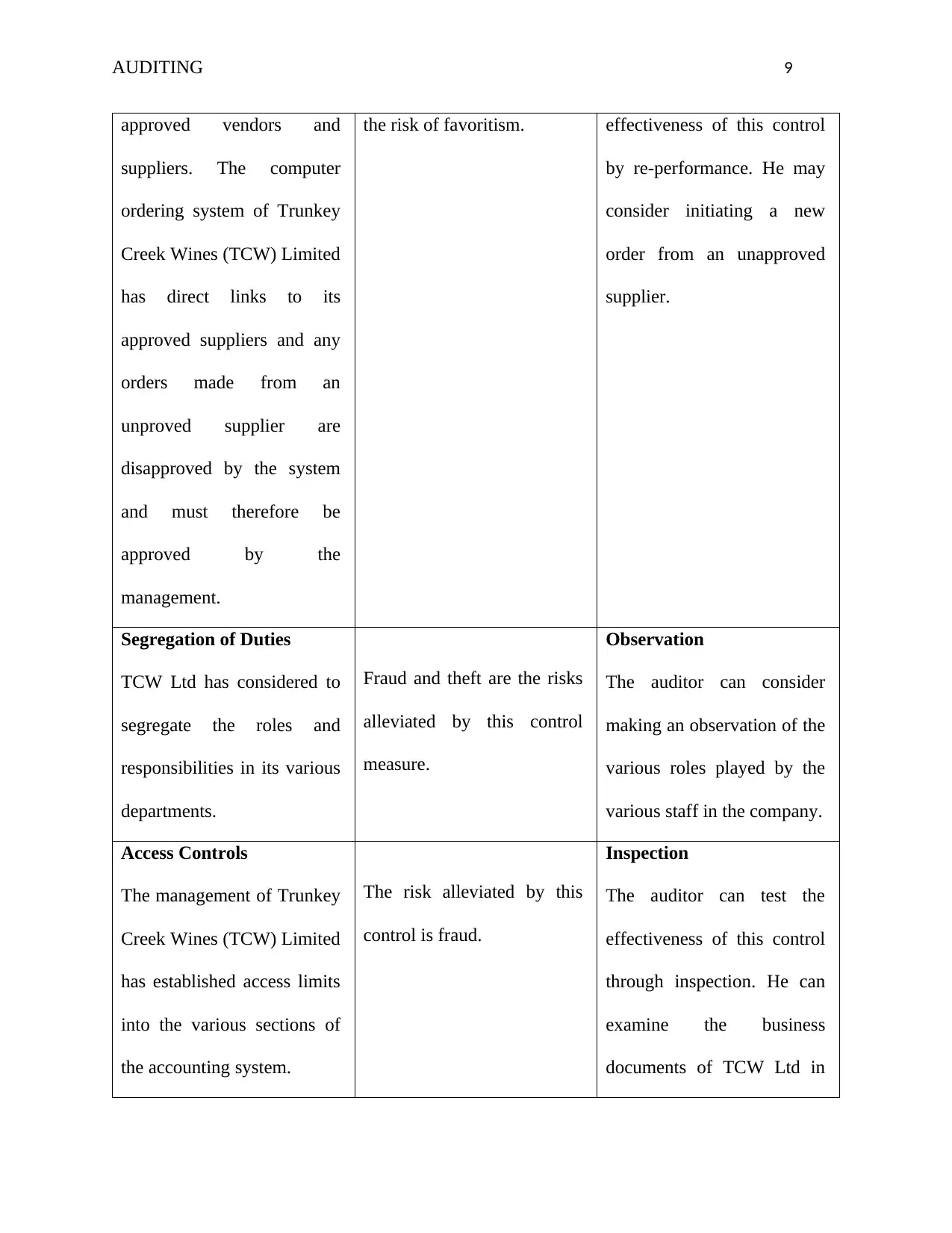
AUDITING 9
approved vendors and
suppliers. The computer
ordering system of Trunkey
Creek Wines (TCW) Limited
has direct links to its
approved suppliers and any
orders made from an
unproved supplier are
disapproved by the system
and must therefore be
approved by the
management.
the risk of favoritism. effectiveness of this control
by re-performance. He may
consider initiating a new
order from an unapproved
supplier.
Segregation of Duties
TCW Ltd has considered to
segregate the roles and
responsibilities in its various
departments.
Fraud and theft are the risks
alleviated by this control
measure.
Observation
The auditor can consider
making an observation of the
various roles played by the
various staff in the company.
Access Controls
The management of Trunkey
Creek Wines (TCW) Limited
has established access limits
into the various sections of
the accounting system.
The risk alleviated by this
control is fraud.
Inspection
The auditor can test the
effectiveness of this control
through inspection. He can
examine the business
documents of TCW Ltd in
approved vendors and
suppliers. The computer
ordering system of Trunkey
Creek Wines (TCW) Limited
has direct links to its
approved suppliers and any
orders made from an
unproved supplier are
disapproved by the system
and must therefore be
approved by the
management.
the risk of favoritism. effectiveness of this control
by re-performance. He may
consider initiating a new
order from an unapproved
supplier.
Segregation of Duties
TCW Ltd has considered to
segregate the roles and
responsibilities in its various
departments.
Fraud and theft are the risks
alleviated by this control
measure.
Observation
The auditor can consider
making an observation of the
various roles played by the
various staff in the company.
Access Controls
The management of Trunkey
Creek Wines (TCW) Limited
has established access limits
into the various sections of
the accounting system.
The risk alleviated by this
control is fraud.
Inspection
The auditor can test the
effectiveness of this control
through inspection. He can
examine the business
documents of TCW Ltd in
⊘ This is a preview!⊘
Do you want full access?
Subscribe today to unlock all pages.

Trusted by 1+ million students worldwide
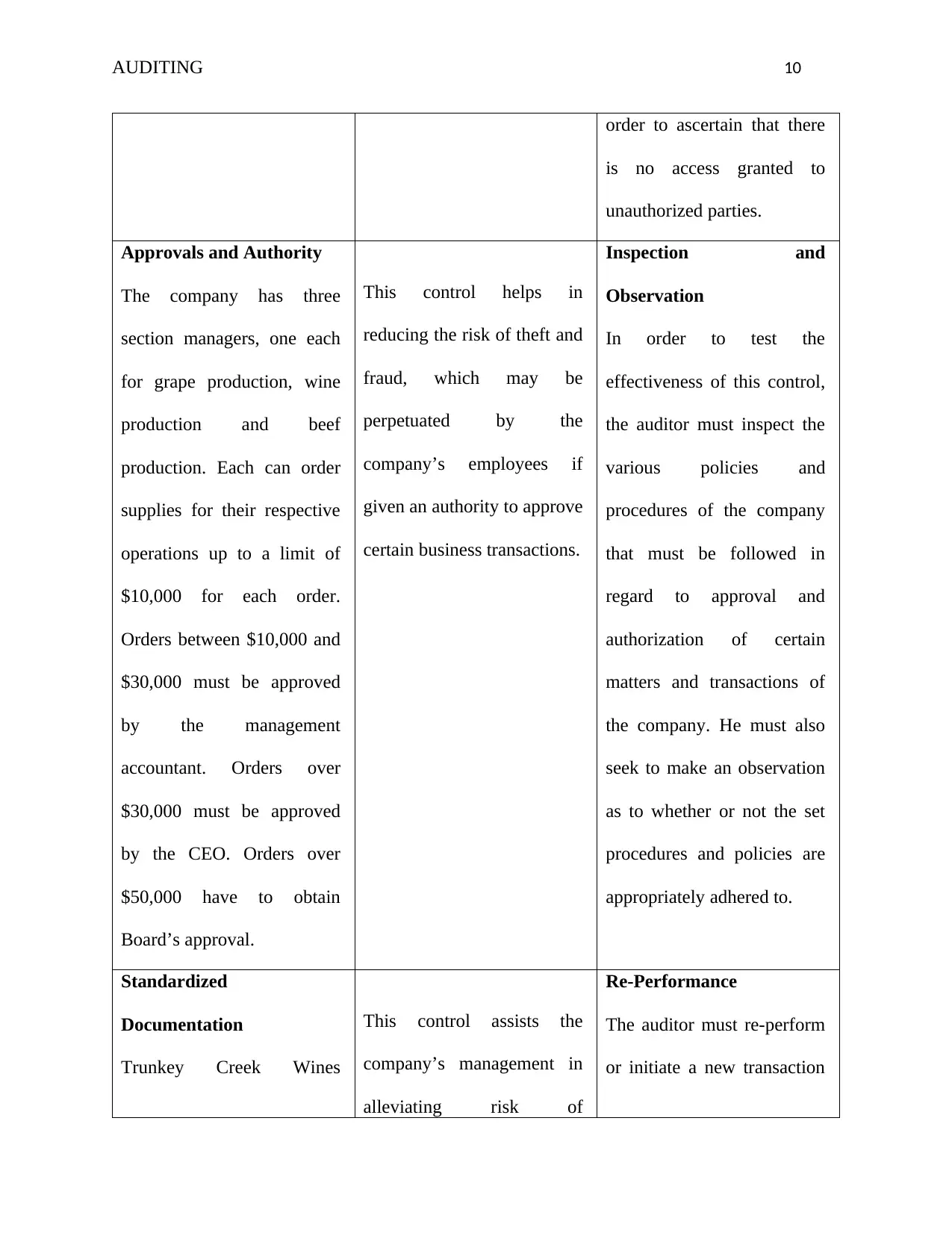
AUDITING 10
order to ascertain that there
is no access granted to
unauthorized parties.
Approvals and Authority
The company has three
section managers, one each
for grape production, wine
production and beef
production. Each can order
supplies for their respective
operations up to a limit of
$10,000 for each order.
Orders between $10,000 and
$30,000 must be approved
by the management
accountant. Orders over
$30,000 must be approved
by the CEO. Orders over
$50,000 have to obtain
Board’s approval.
This control helps in
reducing the risk of theft and
fraud, which may be
perpetuated by the
company’s employees if
given an authority to approve
certain business transactions.
Inspection and
Observation
In order to test the
effectiveness of this control,
the auditor must inspect the
various policies and
procedures of the company
that must be followed in
regard to approval and
authorization of certain
matters and transactions of
the company. He must also
seek to make an observation
as to whether or not the set
procedures and policies are
appropriately adhered to.
Standardized
Documentation
Trunkey Creek Wines
This control assists the
company’s management in
alleviating risk of
Re-Performance
The auditor must re-perform
or initiate a new transaction
order to ascertain that there
is no access granted to
unauthorized parties.
Approvals and Authority
The company has three
section managers, one each
for grape production, wine
production and beef
production. Each can order
supplies for their respective
operations up to a limit of
$10,000 for each order.
Orders between $10,000 and
$30,000 must be approved
by the management
accountant. Orders over
$30,000 must be approved
by the CEO. Orders over
$50,000 have to obtain
Board’s approval.
This control helps in
reducing the risk of theft and
fraud, which may be
perpetuated by the
company’s employees if
given an authority to approve
certain business transactions.
Inspection and
Observation
In order to test the
effectiveness of this control,
the auditor must inspect the
various policies and
procedures of the company
that must be followed in
regard to approval and
authorization of certain
matters and transactions of
the company. He must also
seek to make an observation
as to whether or not the set
procedures and policies are
appropriately adhered to.
Standardized
Documentation
Trunkey Creek Wines
This control assists the
company’s management in
alleviating risk of
Re-Performance
The auditor must re-perform
or initiate a new transaction
Paraphrase This Document
Need a fresh take? Get an instant paraphrase of this document with our AI Paraphraser
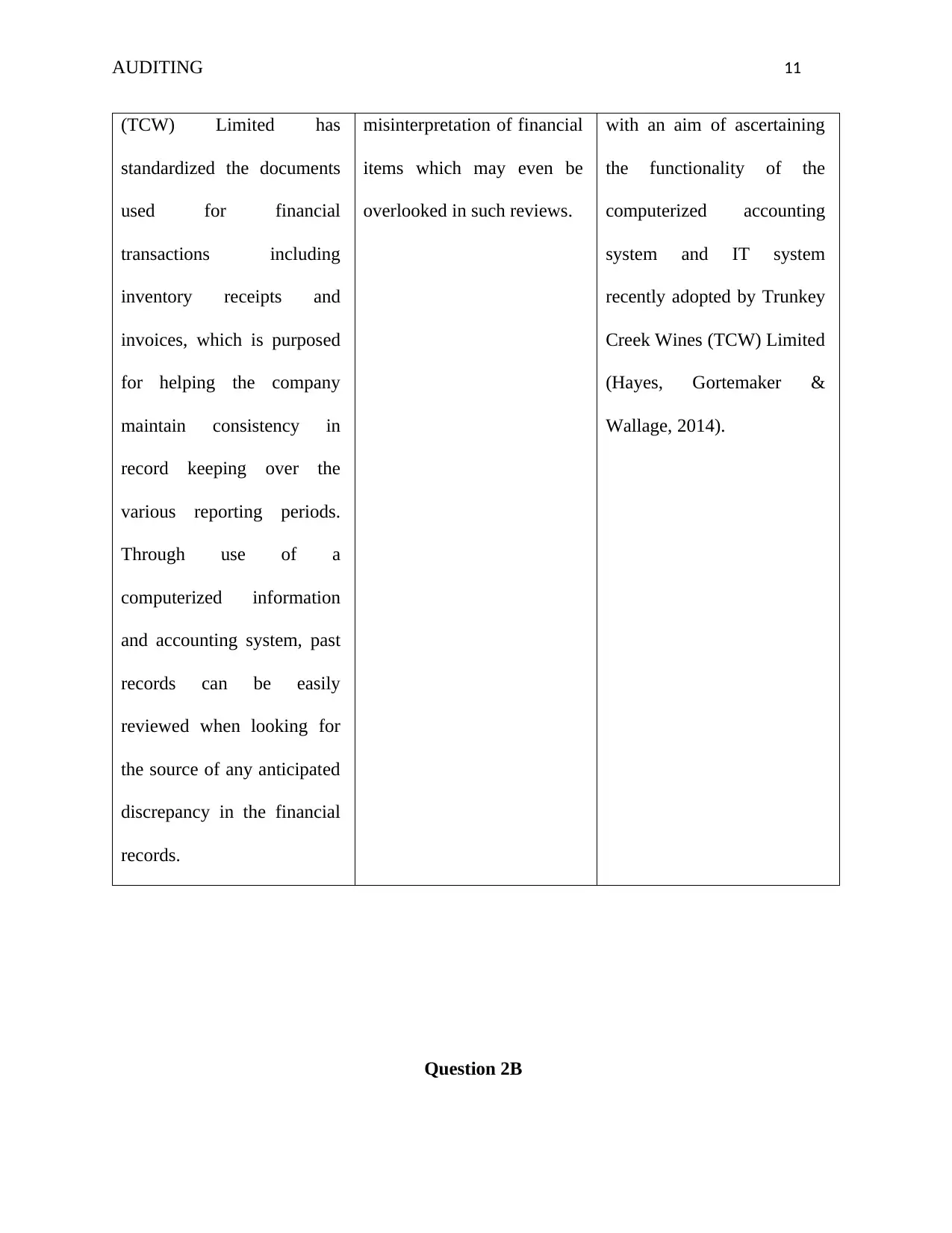
AUDITING 11
(TCW) Limited has
standardized the documents
used for financial
transactions including
inventory receipts and
invoices, which is purposed
for helping the company
maintain consistency in
record keeping over the
various reporting periods.
Through use of a
computerized information
and accounting system, past
records can be easily
reviewed when looking for
the source of any anticipated
discrepancy in the financial
records.
misinterpretation of financial
items which may even be
overlooked in such reviews.
with an aim of ascertaining
the functionality of the
computerized accounting
system and IT system
recently adopted by Trunkey
Creek Wines (TCW) Limited
(Hayes, Gortemaker &
Wallage, 2014).
Question 2B
(TCW) Limited has
standardized the documents
used for financial
transactions including
inventory receipts and
invoices, which is purposed
for helping the company
maintain consistency in
record keeping over the
various reporting periods.
Through use of a
computerized information
and accounting system, past
records can be easily
reviewed when looking for
the source of any anticipated
discrepancy in the financial
records.
misinterpretation of financial
items which may even be
overlooked in such reviews.
with an aim of ascertaining
the functionality of the
computerized accounting
system and IT system
recently adopted by Trunkey
Creek Wines (TCW) Limited
(Hayes, Gortemaker &
Wallage, 2014).
Question 2B
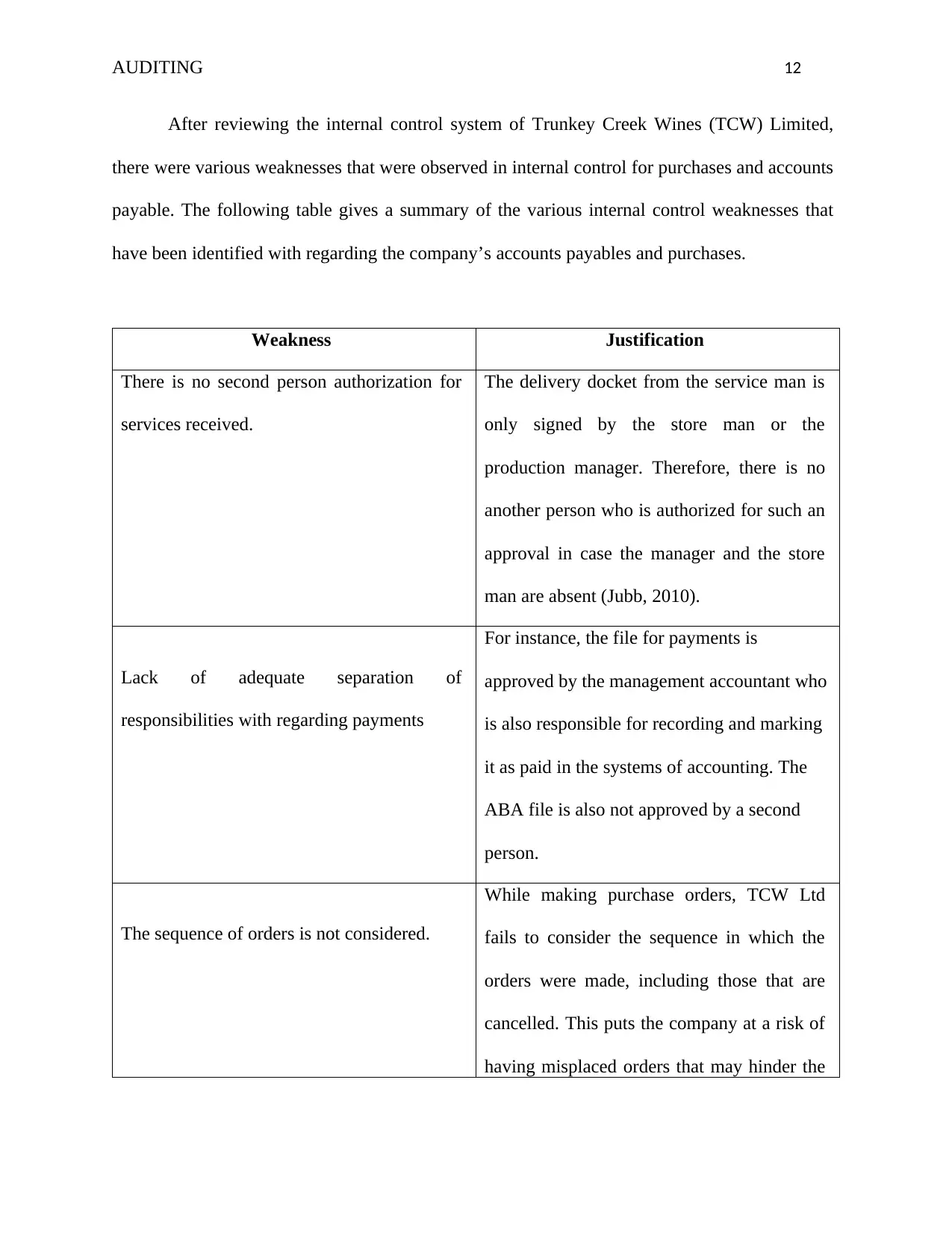
AUDITING 12
After reviewing the internal control system of Trunkey Creek Wines (TCW) Limited,
there were various weaknesses that were observed in internal control for purchases and accounts
payable. The following table gives a summary of the various internal control weaknesses that
have been identified with regarding the company’s accounts payables and purchases.
Weakness Justification
There is no second person authorization for
services received.
The delivery docket from the service man is
only signed by the store man or the
production manager. Therefore, there is no
another person who is authorized for such an
approval in case the manager and the store
man are absent (Jubb, 2010).
Lack of adequate separation of
responsibilities with regarding payments
For instance, the file for payments is
approved by the management accountant who
is also responsible for recording and marking
it as paid in the systems of accounting. The
ABA file is also not approved by a second
person.
The sequence of orders is not considered.
While making purchase orders, TCW Ltd
fails to consider the sequence in which the
orders were made, including those that are
cancelled. This puts the company at a risk of
having misplaced orders that may hinder the
After reviewing the internal control system of Trunkey Creek Wines (TCW) Limited,
there were various weaknesses that were observed in internal control for purchases and accounts
payable. The following table gives a summary of the various internal control weaknesses that
have been identified with regarding the company’s accounts payables and purchases.
Weakness Justification
There is no second person authorization for
services received.
The delivery docket from the service man is
only signed by the store man or the
production manager. Therefore, there is no
another person who is authorized for such an
approval in case the manager and the store
man are absent (Jubb, 2010).
Lack of adequate separation of
responsibilities with regarding payments
For instance, the file for payments is
approved by the management accountant who
is also responsible for recording and marking
it as paid in the systems of accounting. The
ABA file is also not approved by a second
person.
The sequence of orders is not considered.
While making purchase orders, TCW Ltd
fails to consider the sequence in which the
orders were made, including those that are
cancelled. This puts the company at a risk of
having misplaced orders that may hinder the
⊘ This is a preview!⊘
Do you want full access?
Subscribe today to unlock all pages.

Trusted by 1+ million students worldwide
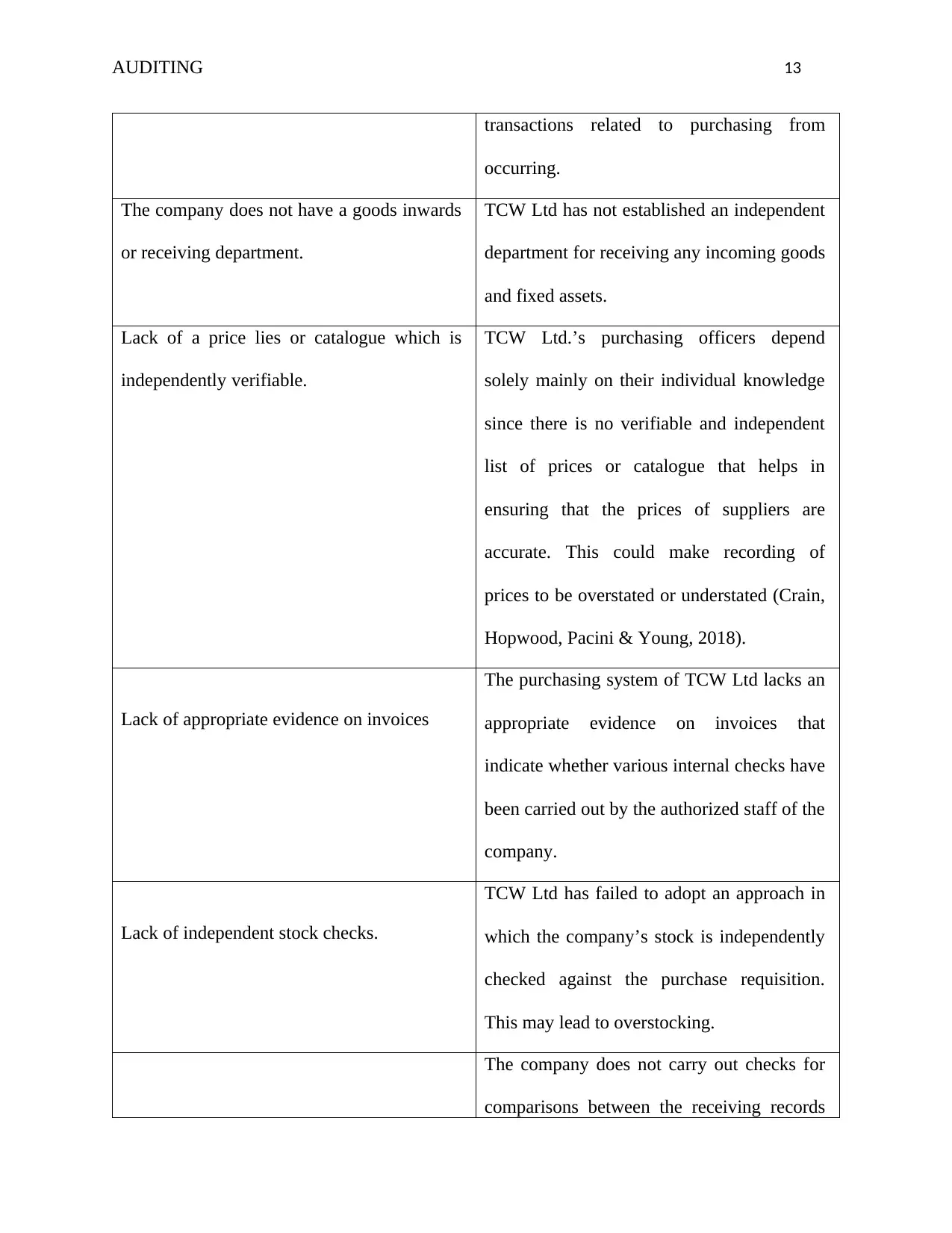
AUDITING 13
transactions related to purchasing from
occurring.
The company does not have a goods inwards
or receiving department.
TCW Ltd has not established an independent
department for receiving any incoming goods
and fixed assets.
Lack of a price lies or catalogue which is
independently verifiable.
TCW Ltd.’s purchasing officers depend
solely mainly on their individual knowledge
since there is no verifiable and independent
list of prices or catalogue that helps in
ensuring that the prices of suppliers are
accurate. This could make recording of
prices to be overstated or understated (Crain,
Hopwood, Pacini & Young, 2018).
Lack of appropriate evidence on invoices
The purchasing system of TCW Ltd lacks an
appropriate evidence on invoices that
indicate whether various internal checks have
been carried out by the authorized staff of the
company.
Lack of independent stock checks.
TCW Ltd has failed to adopt an approach in
which the company’s stock is independently
checked against the purchase requisition.
This may lead to overstocking.
The company does not carry out checks for
comparisons between the receiving records
transactions related to purchasing from
occurring.
The company does not have a goods inwards
or receiving department.
TCW Ltd has not established an independent
department for receiving any incoming goods
and fixed assets.
Lack of a price lies or catalogue which is
independently verifiable.
TCW Ltd.’s purchasing officers depend
solely mainly on their individual knowledge
since there is no verifiable and independent
list of prices or catalogue that helps in
ensuring that the prices of suppliers are
accurate. This could make recording of
prices to be overstated or understated (Crain,
Hopwood, Pacini & Young, 2018).
Lack of appropriate evidence on invoices
The purchasing system of TCW Ltd lacks an
appropriate evidence on invoices that
indicate whether various internal checks have
been carried out by the authorized staff of the
company.
Lack of independent stock checks.
TCW Ltd has failed to adopt an approach in
which the company’s stock is independently
checked against the purchase requisition.
This may lead to overstocking.
The company does not carry out checks for
comparisons between the receiving records
Paraphrase This Document
Need a fresh take? Get an instant paraphrase of this document with our AI Paraphraser
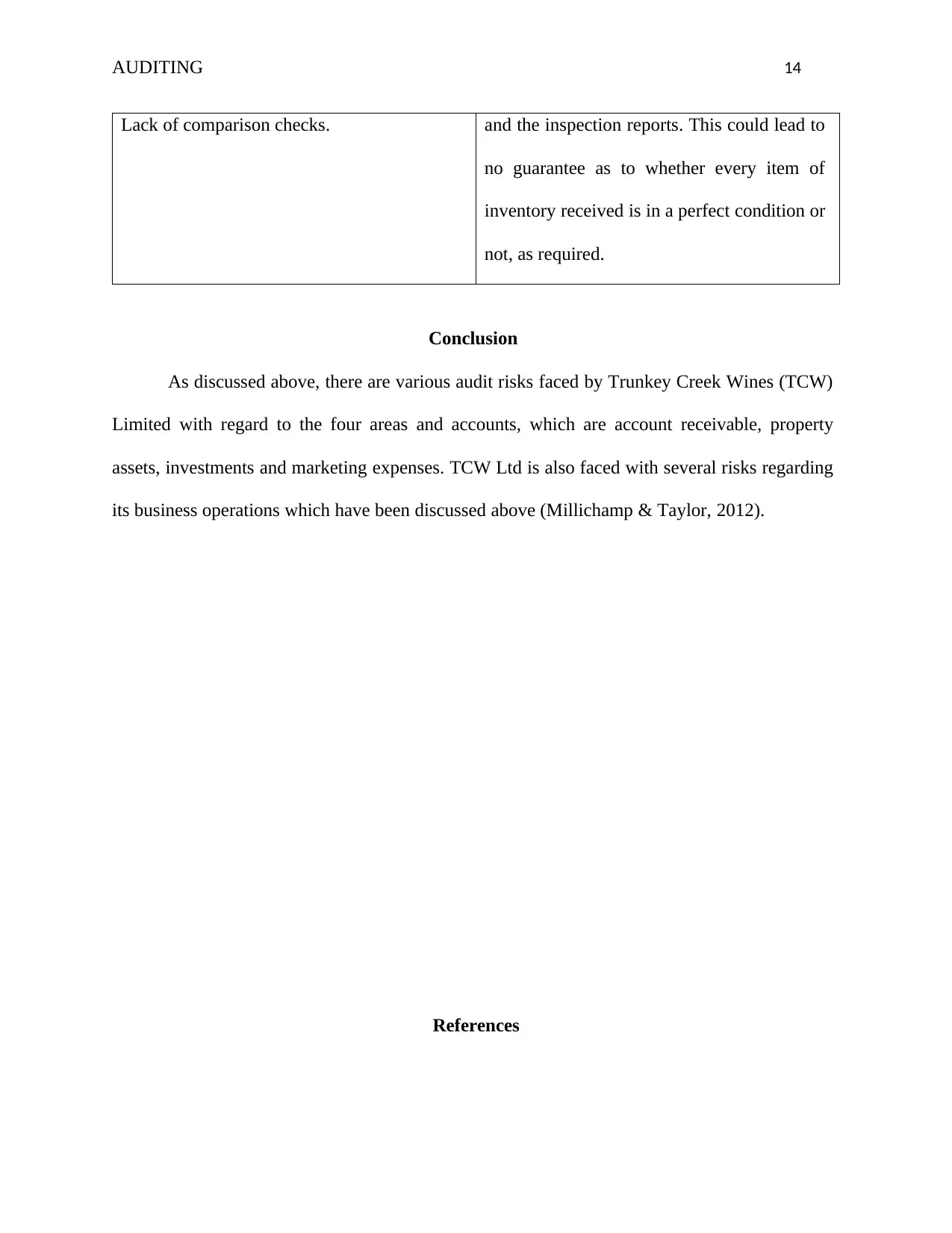
AUDITING 14
Lack of comparison checks. and the inspection reports. This could lead to
no guarantee as to whether every item of
inventory received is in a perfect condition or
not, as required.
Conclusion
As discussed above, there are various audit risks faced by Trunkey Creek Wines (TCW)
Limited with regard to the four areas and accounts, which are account receivable, property
assets, investments and marketing expenses. TCW Ltd is also faced with several risks regarding
its business operations which have been discussed above (Millichamp & Taylor, 2012).
References
Lack of comparison checks. and the inspection reports. This could lead to
no guarantee as to whether every item of
inventory received is in a perfect condition or
not, as required.
Conclusion
As discussed above, there are various audit risks faced by Trunkey Creek Wines (TCW)
Limited with regard to the four areas and accounts, which are account receivable, property
assets, investments and marketing expenses. TCW Ltd is also faced with several risks regarding
its business operations which have been discussed above (Millichamp & Taylor, 2012).
References
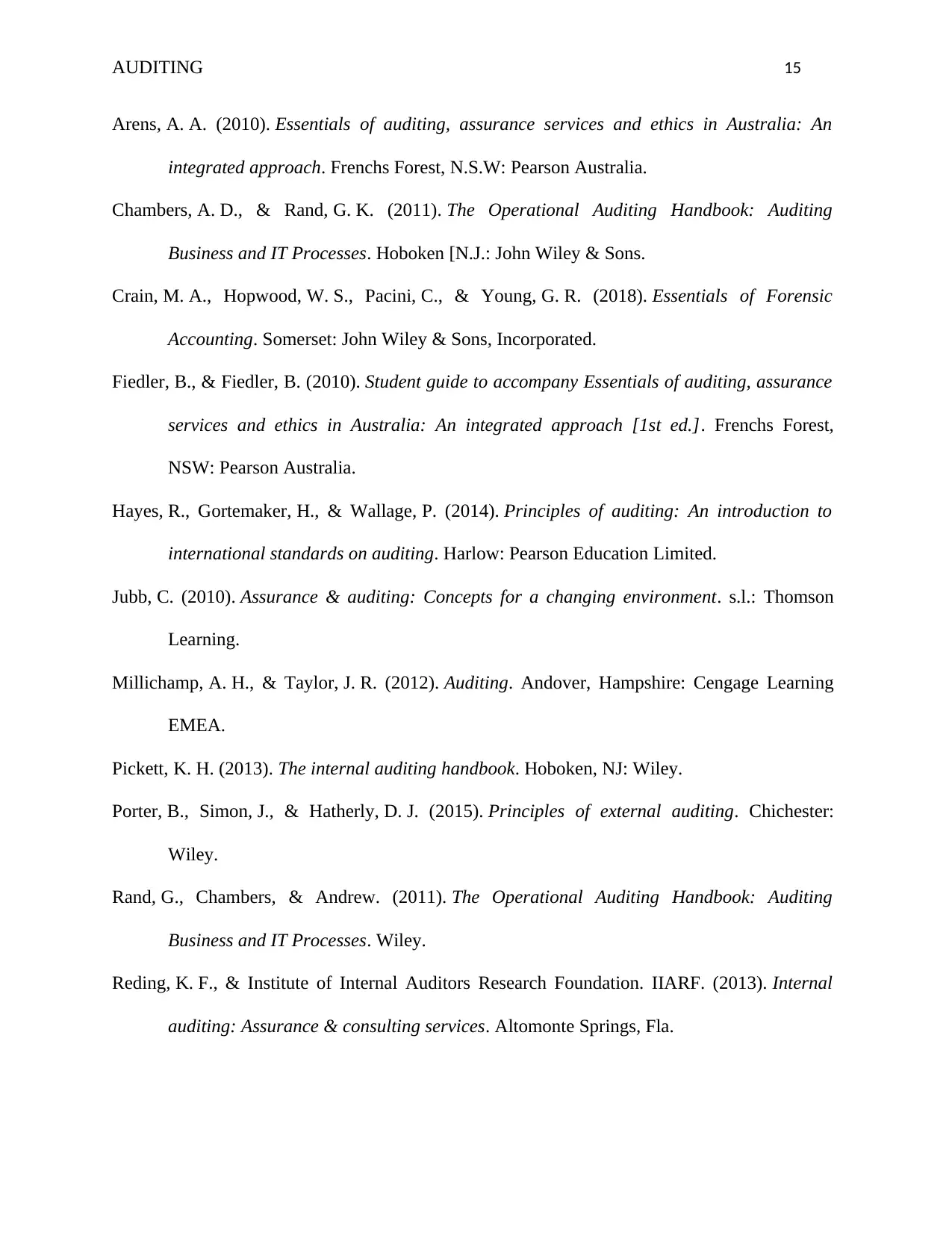
AUDITING 15
Arens, A. A. (2010). Essentials of auditing, assurance services and ethics in Australia: An
integrated approach. Frenchs Forest, N.S.W: Pearson Australia.
Chambers, A. D., & Rand, G. K. (2011). The Operational Auditing Handbook: Auditing
Business and IT Processes. Hoboken [N.J.: John Wiley & Sons.
Crain, M. A., Hopwood, W. S., Pacini, C., & Young, G. R. (2018). Essentials of Forensic
Accounting. Somerset: John Wiley & Sons, Incorporated.
Fiedler, B., & Fiedler, B. (2010). Student guide to accompany Essentials of auditing, assurance
services and ethics in Australia: An integrated approach [1st ed.]. Frenchs Forest,
NSW: Pearson Australia.
Hayes, R., Gortemaker, H., & Wallage, P. (2014). Principles of auditing: An introduction to
international standards on auditing. Harlow: Pearson Education Limited.
Jubb, C. (2010). Assurance & auditing: Concepts for a changing environment. s.l.: Thomson
Learning.
Millichamp, A. H., & Taylor, J. R. (2012). Auditing. Andover, Hampshire: Cengage Learning
EMEA.
Pickett, K. H. (2013). The internal auditing handbook. Hoboken, NJ: Wiley.
Porter, B., Simon, J., & Hatherly, D. J. (2015). Principles of external auditing. Chichester:
Wiley.
Rand, G., Chambers, & Andrew. (2011). The Operational Auditing Handbook: Auditing
Business and IT Processes. Wiley.
Reding, K. F., & Institute of Internal Auditors Research Foundation. IIARF. (2013). Internal
auditing: Assurance & consulting services. Altomonte Springs, Fla.
Arens, A. A. (2010). Essentials of auditing, assurance services and ethics in Australia: An
integrated approach. Frenchs Forest, N.S.W: Pearson Australia.
Chambers, A. D., & Rand, G. K. (2011). The Operational Auditing Handbook: Auditing
Business and IT Processes. Hoboken [N.J.: John Wiley & Sons.
Crain, M. A., Hopwood, W. S., Pacini, C., & Young, G. R. (2018). Essentials of Forensic
Accounting. Somerset: John Wiley & Sons, Incorporated.
Fiedler, B., & Fiedler, B. (2010). Student guide to accompany Essentials of auditing, assurance
services and ethics in Australia: An integrated approach [1st ed.]. Frenchs Forest,
NSW: Pearson Australia.
Hayes, R., Gortemaker, H., & Wallage, P. (2014). Principles of auditing: An introduction to
international standards on auditing. Harlow: Pearson Education Limited.
Jubb, C. (2010). Assurance & auditing: Concepts for a changing environment. s.l.: Thomson
Learning.
Millichamp, A. H., & Taylor, J. R. (2012). Auditing. Andover, Hampshire: Cengage Learning
EMEA.
Pickett, K. H. (2013). The internal auditing handbook. Hoboken, NJ: Wiley.
Porter, B., Simon, J., & Hatherly, D. J. (2015). Principles of external auditing. Chichester:
Wiley.
Rand, G., Chambers, & Andrew. (2011). The Operational Auditing Handbook: Auditing
Business and IT Processes. Wiley.
Reding, K. F., & Institute of Internal Auditors Research Foundation. IIARF. (2013). Internal
auditing: Assurance & consulting services. Altomonte Springs, Fla.
⊘ This is a preview!⊘
Do you want full access?
Subscribe today to unlock all pages.

Trusted by 1+ million students worldwide
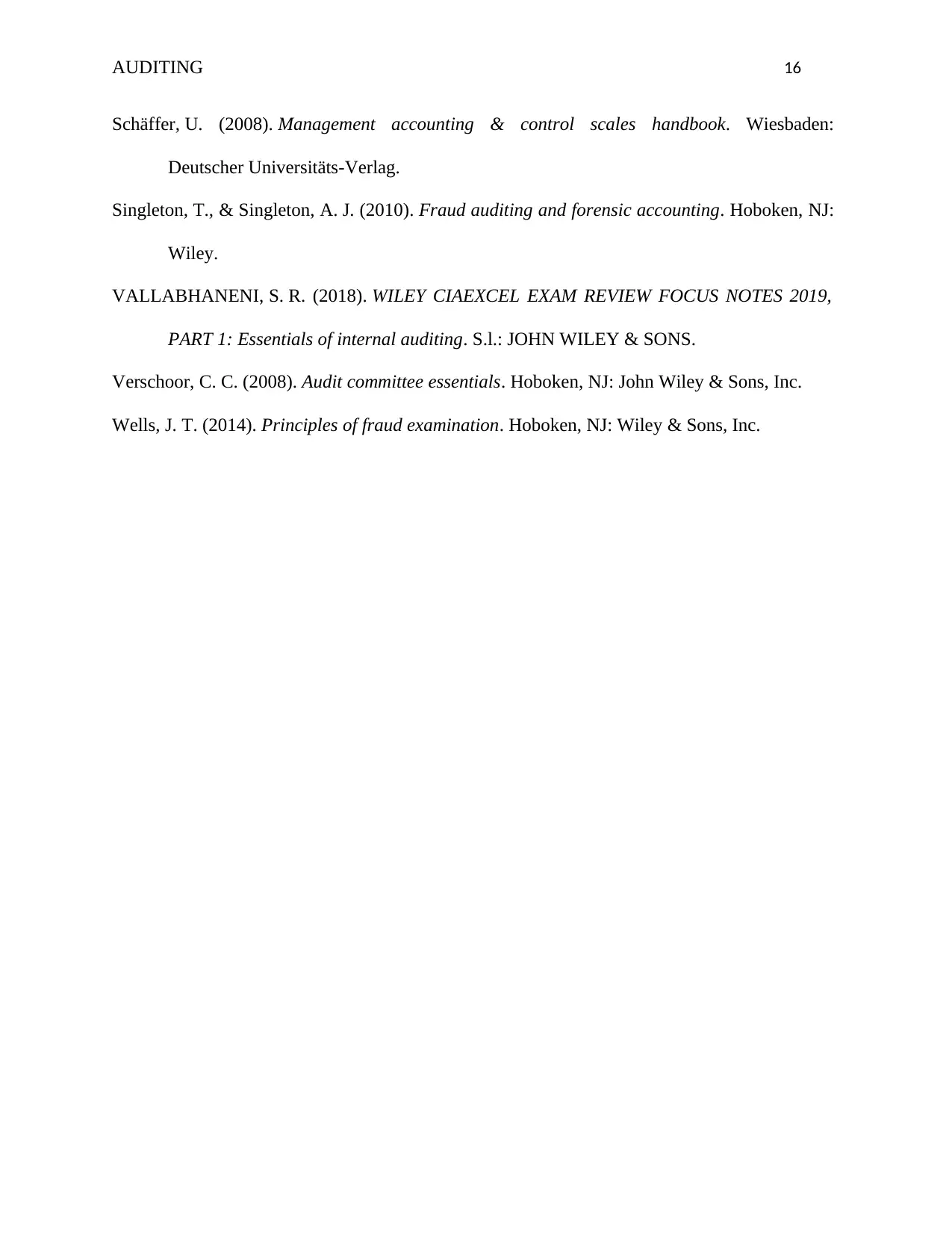
AUDITING 16
Schäffer, U. (2008). Management accounting & control scales handbook. Wiesbaden:
Deutscher Universitäts-Verlag.
Singleton, T., & Singleton, A. J. (2010). Fraud auditing and forensic accounting. Hoboken, NJ:
Wiley.
VALLABHANENI, S. R. (2018). WILEY CIAEXCEL EXAM REVIEW FOCUS NOTES 2019,
PART 1: Essentials of internal auditing. S.l.: JOHN WILEY & SONS.
Verschoor, C. C. (2008). Audit committee essentials. Hoboken, NJ: John Wiley & Sons, Inc.
Wells, J. T. (2014). Principles of fraud examination. Hoboken, NJ: Wiley & Sons, Inc.
Schäffer, U. (2008). Management accounting & control scales handbook. Wiesbaden:
Deutscher Universitäts-Verlag.
Singleton, T., & Singleton, A. J. (2010). Fraud auditing and forensic accounting. Hoboken, NJ:
Wiley.
VALLABHANENI, S. R. (2018). WILEY CIAEXCEL EXAM REVIEW FOCUS NOTES 2019,
PART 1: Essentials of internal auditing. S.l.: JOHN WILEY & SONS.
Verschoor, C. C. (2008). Audit committee essentials. Hoboken, NJ: John Wiley & Sons, Inc.
Wells, J. T. (2014). Principles of fraud examination. Hoboken, NJ: Wiley & Sons, Inc.
1 out of 16
Related Documents
Your All-in-One AI-Powered Toolkit for Academic Success.
+13062052269
info@desklib.com
Available 24*7 on WhatsApp / Email
![[object Object]](/_next/static/media/star-bottom.7253800d.svg)
Unlock your academic potential
© 2024 | Zucol Services PVT LTD | All rights reserved.



